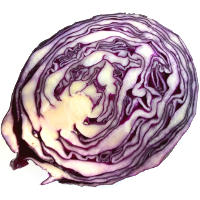Health Benefits of Red Cabbage (vs White Cabbage)

The potential health benefits of red cabbage are truly impressive. Analysis of the nutritional profile of red cabbage reveals that this tasty member of the Brassica family of plants is loaded with a range of health benefiting nutrients and phytochemicals, including vitamin C, anthocyanins, and glucosinolates. Also known as purple cabbage or Brassica oleracea var. capitata f. rubra in the sicentific circles, red cabbage is also packed with vitamin K, although it does not contain quite as much of this heart health boosting nutrient as green cabbage.
In this in-depth article, we take a look at the various nutrients that make red cabbage so good for you, plus provide some interesting facts about the differences in the nutritional value of red cabbage versus white cabbage.
Red cabbage has more vitamin C than white cabbage – or oranges!
So you thought
those healthy navel oranges in your fruit bowl are the best dietary source of vitamin C you can reach for? Well, guess what, raw red cabbage contains even more vitamin C than fresh oranges! One ounce (28 grams) of raw red cabbage provides a whopping 27 percent of the Daily Value (DV) for vitamin C, while an equal-sized serving of oranges contains 25 percent of the DV for this important nutrient. For the sake of comparison, green cabbage varieties (including white cabbage) contain about 17 percent of the DV per 1 ounce.
Vitamin C is perhaps best known for its immune-boosting properties, but did you know that it can also help keep your skin, bones, and teeth healthy. Most of the health benefits associated with the consumption of vitamin C rich foods, such as cabbage, are believed to be linked to the antioxidant activities of vitamin C, but also its ability to stimulate collagen synthesis is thought to play a role.
Tip: To maximize the health benefits of red or white cabbage derived from their high vitamin C content, make sure your meal also contains some
foods that provide vitamin E as these two vitamins work best synergistically.
Red cabbage contains the same 'super antioxidant' as aronia berries
Unlike green and white cabbage varieties, red cabbage contains anthocyanins, the same red flavonoid pigments that are responsible for many of the famous
health benefits of aronia berries (chokeberries),
blue honeyberries, and many other blue, red, and purple berries and fruits. Using oxygen radical absorbance capacity (ORAC) as a measure, a team of scientists from the Jean Mayer USDA Human Nutrition Research Center on Aging have shown that anthocyanins have extremely strong antioxidant properties in vitro, even stronger than Trolox which is a vitamin E analogue.
Numerous studies suggest that antioxidants help protect your body from the effects of free radicals, unstable atoms that promote the development of many degenerative diseases and pre-mature aging of the skin. People who are frequently exposed to things like pollution, drugs, cigarette smoke, toxic wastes, stress, and UV radiation are likely to have higher levels of free radicals in their bodies.
One study assessing the effects of anthocyanins was carried out specifically to assess the health benefits of red cabbage anthocyanins and purple sweet potato anthocyanins in rats with colorectal cancer. This study, which was published in The Journal of Toxicological Sciences in February 2002, found that both sweet potato and red cabbage anthocyanins had anti-cancer effects under the experimental conditions used in this study.
Red cabbage contains more glucosinolates than its white counterpart
Also several epidemiological studies (studies that compare groups of people) have found a link between a high consumption of Brassica vegetables, such as cabbage, and a reduced risk of certain types of cancer. In case of red cabbage, some of its potential cancer-fighting effects can be attributed to the anthocyanins it contains; however, also the glucosinolates it delivers are thought to provide significant benefits. Glucosinolates, present in almost all Brassica vegetables, are pre-cursors to biologically active isothiocyanates which have been shown to destroy carcinogenic substances and to hinder cancer cell proliferation.
Interestingly, however, there seems to be significant differences in the glucosinolate content of different Brassica vegetables. In 2010, an intriguing study comparing the glucosinolate content of 11 Brassica oleracea crops (consisting of 42 cultivars) was published in Acta Horticulturae. This study reported that the total glucosinolate content varied from 14 to 625 μmol/100 g (fresh weight, or FW) among the tested Brassicas.
White cabbage was shown to contain high levels of glucosinolates, much higher than many other Brassica vegetables, but red cabbage had even higher levels! The total level of glucosinolates in red cabbage ranged from 140 to 381 μmol/100 g FW, while the glucosinolate content of white cabbage was in the range 127 to 241 μmol/100 g FW.
Green cabbage is the vitamin K champion
Red cabbage is also loaded with vitamin K, although it does not beat the green cabbage, the vitamin K champion. According to USDA's Nutrition Facts data, 1 ounce of raw red cabbage provides provides your body with about 13% of the Daily Value for vitamin K. By way of comparison, eating just one ounce of green cabbage will supply your body with a whopping 27% of the Daily Value for vitamin K.
Vitamin K is best known for its role in blood coagulation, but emerging research suggests it may also be one of the
best vitamins for cardiovascular health and bone health: Vitamin K helps direct calcium into the bone, thereby reducing the risk of calcium build-up in blood vessels.
Source: http://www.healwithfood.org/health-benefits/red-cabbage-vs-white.php#ixzz3zWoaBS1t













